英语名词的用法及练习_完整整理版本
- 格式:doc
- 大小:81.50 KB
- 文档页数:35
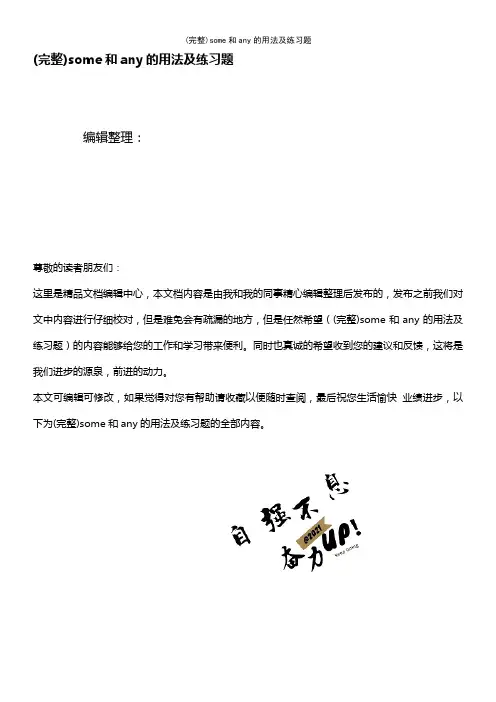
(完整)some和any的用法及练习题编辑整理:尊敬的读者朋友们:这里是精品文档编辑中心,本文档内容是由我和我的同事精心编辑整理后发布的,发布之前我们对文中内容进行仔细校对,但是难免会有疏漏的地方,但是任然希望((完整)some和any的用法及练习题)的内容能够给您的工作和学习带来便利。
同时也真诚的希望收到您的建议和反馈,这将是我们进步的源泉,前进的动力。
本文可编辑可修改,如果觉得对您有帮助请收藏以便随时查阅,最后祝您生活愉快业绩进步,以下为(完整)some和any的用法及练习题的全部内容。
some和any的用法及练习题(一)一、用法:some意思为:一些.可用来修饰可数名词和不可数名词,常常用于肯定句。
any意思为:任何一些。
它可以修饰可数名词和不可数名词,当修饰可数名词时要用复数形式。
常用于否定句和疑问句。
注意:1、在表示请求和邀请时,some也可以用在疑问句中。
2、表示“任何”或“任何一个”时,也可以用在肯定句中.3、和后没有名词时,用作代词,也可用作副词.二、练习题:1.There are ( )newspapers on the table。
2。
Is there ( )bread on the plate.3.Are there () boats on the river?4。
-—-Do you have () brothers ?—--Yes ,I have two brothers。
5.—--Is there ( ) tea in the cup?—--Yes,there is ( ) tea in it ,but there isn’t milk.6.I want to ask you ( ) questions.7。
My little boy wants ()water to drink。
8.There are ( ) tables in the room ,but there aren't ( )chairs. 9。
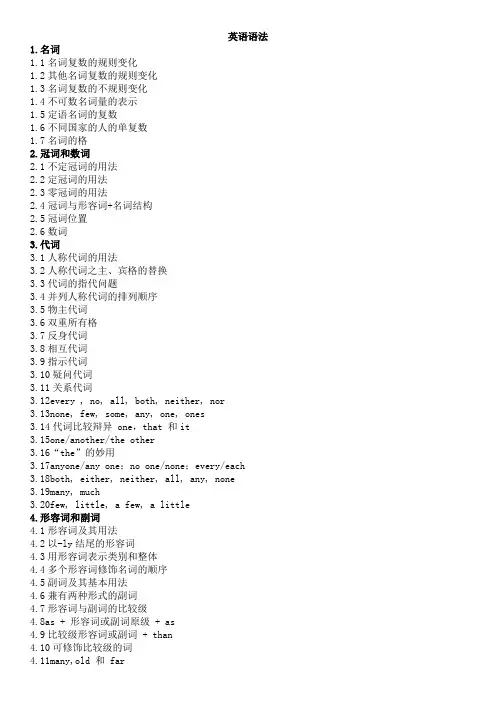
英语语法1.名词1.1名词复数的规则变化1.2其他名词复数的规则变化1.3名词复数的不规则变化1.4不可数名词量的表示1.5定语名词的复数1.6不同国家的人的单复数1.7名词的格2.冠词和数词2.1不定冠词的用法2.2定冠词的用法2.3零冠词的用法2.4冠词与形容词+名词结构2.5冠词位置2.6数词3.代词3.1人称代词的用法3.2人称代词之主、宾格的替换3.3代词的指代问题3.4并列人称代词的排列顺序3.5物主代词3.6双重所有格3.7反身代词3.8相互代词3.9指示代词3.10疑问代词3.11关系代词3.12every , no, all, both, neither, nor3.13none, few, some, any, one, ones3.14代词比较辩异 one,that 和it3.15one/another/the other3.16“the”的妙用3.17anyone/any one;no one/none;every/each3.18both, either, neither, all, any, none3.19many, much3.20few, little, a few, a little4.形容词和副词4.1形容词及其用法4.2以-ly结尾的形容词4.3用形容词表示类别和整体4.4多个形容词修饰名词的顺序4.5副词及其基本用法4.6兼有两种形式的副词4.7形容词与副词的比较级4.8as + 形容词或副词原级 + as4.9比较级形容词或副词 + than4.10可修饰比较级的词4.11many,old 和 far4.12the + 最高级 + 比较范围4.13和more有关的词组5.动词5.1系动词5.2什么是助动词5.3助动词be的用法5.4助动词have的用法5.5助动词do的用法5.6助动词shall和will的用法5.7助动词should和would的用法5.8短语动词5.9非谓语动词6.动名词6.1动名词作主语、宾语和表语6.2Worth的用法7动词不定式7.1不定式作宾语7.2不定式作补语7.3不定式主语7.4It's for sb.和 It's of sb.7.5不定式作表语7.6不定式作定语7.7不定式作状语7.8用作介词的to7.9省to 的动词不定式7.10动词不定式的否定式7.11不定式的特殊句型too…to…7.12不定式的特殊句型so as to 7.13不定式的特殊句型Why not 7.147不定式的时态和语态7.15动名词与不定式8.特殊词精讲8.1stop doing/to do8.2forget doing/to do8.3remember doing/to do8.4regret doing/to do8.5cease doing/to do8.6try doing/to do8.7go on doing/to do8.8be afraid doing/to do8.9be interested doing/to do 8.10mean to doing/to do8.11begin(start) doing/to do8.12感官动词 + doing/to do9.分词9.1分词作定语9.2分词作状语9.3连词+分词(短语)9.4分词作补语9.5分词作表语9.6分词作插入语9.7分词的时态9.8分词的语态10.独立主格10.1独立主格10.2With的复合结构11.动词的时态11.1一般现在时的用法11.2一般过去时的用法11.3used to / be used to 11.4一般将来时11.5be going to / will11.6be to和be going to11.7一般现在时表将来11.8用现在进行时表示将来11.9现在完成时11.10比较过去时与现在完成时11.11用于现在完成时的句型11.12比较since和for11.13since的四种用法11.14延续动词与瞬间动词11.15过去完成时11.16用一般过去时代替完成时11.17将来完成时11.18现在进行时11.19不用进行时的动词11.20过去进行时11.21将来进行时11.22一般现在时代替将来时11.23一般现在时代替过去时11.24一般现在时代替完成时11.25一般现在时代替完成时11.26一般现在时代替进行时11.27现在进行时代替将来时11.28时态一致1.29时态与时间状语12.动词的语态12.1Let的用法12.2短语动词的被动语态12.3表示"据说"或"相信" 的词组12.4不用被动语态的情况12.5主动形式表示被动意义12.6被动语态表示主动意义12.7need/want/require/worth13.句子的种类13.1句子的种类13.2感叹句结构13.3强调句结构13.4用助动词进行强调13.5反意疑问句14.倒装14.1倒装句之全部倒装14.2倒装句之部分倒装14.3以否定词开头作部分倒装14.4so, neither, nor作部分倒装14.5only在句首要倒装的情况14.6as, though 引导的倒装句14.7其他部分倒装15.主谓一致15.1并列结构作主语谓语用复数15.2主谓一致中的靠近原则15.3谓语动词与前面的主语一致15.4谓语需用单数15.5指代意义决定谓语的单复数15.6与后接名词或代词保持一致16.虚拟语气16.1真是条件句16.2非真实条件句16.3混合条件句16.4虚拟条件句的倒装16.5特殊的虚拟语气词:should16.6wish的用法16.7比较if only与only if16.8It is (high) time that16.9need "不必做"和"本不该做"17.名词性从句17.1引导名词性从句的连接词17.2名词性that-从句17.3名词性wh-从句17.4if, whether引导的名词从句17.5否定转移18.定语从句18.1关系代词引导的定语从句18.2关系副词引导的定语从句18.3判断关系代词与关系副词18.4限制性和非限制性定语从句18.5介词+关系词18.6as, which 非限定性定语从句18.7先行词和关系词二合一18.8what/whatever;that/what; who/whoever18.9关系代词that 的用法19.状语从句19.1地点状语从句19.2方式状语从句19.3原因状语从句19.4目的状语从句19.5结果状语从句19.6条件状语从句19.7让步状语从句19.8比较while, when, as19.9比较until和till19.10表示"一…就…"的结构20.连词20.1并列连词与并列结构20.2比较and和or20.3表示选择的并列结构20.4表示转折或对比20.5表原因关系20.6比较so和 such21.情态动词21.1情态动词的语法特征21.2比较can 和be able to21.3比较may和might21.4比较have to和must21.5比较have to和must21.6must表示推测21.7表示推测的用法21.8情态动词+ have +过去分词21.9should 和ought to21.10had better表示"最好"21.11would rather表示"宁愿"21.12will和would21.13情态动词的回答方式21.14带to 的情态动词21.15比较need和dare1.名词名词可以分为专有名词(Proper Nouns)和普通名词(Common Nouns),专有名词是某个(些)人,地方,机构等专有的名称,如Beijing,China等。
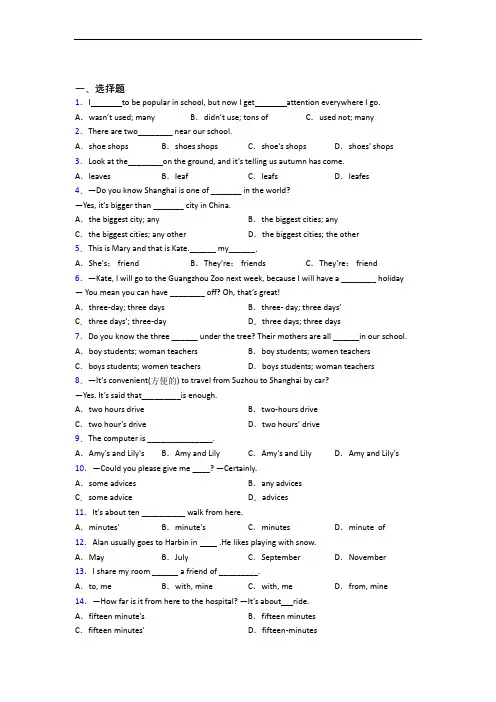
一、选择题1.I to be popular in school, but now I get attention everywhere I go. A.wasn’t used; many B.didn’t use; tons of C.used not; many 2.There are two________ near our school.A.shoe shops B.shoes shops C.shoe's shops D.shoes' shops 3.Look at the________on the ground, and it’s telling us autumn has come.A.leaves B.leaf C.leafs D.leafes 4.—Do you know Shanghai is one of _______ in the world?—Yes, it’s bigger than _______ city in China.A.the biggest city; any B.the biggest cities; anyC.the biggest cities; any other D.the biggest cities; the other5.This is Mary and that is Kate.______ my______.A.She's; friend B.They're; friends C.They're; friend 6.—Kate, I will go to the Guangzhou Zoo next week, because I will have a ________ holiday —You mean you can have ________ off? Oh, that’s great!A.three-day; three days B.three- day; three days’C.three days’; three-day D.three days; three days7.Do you know the three ______ under the tree? Their mothers are all ______in our school. A.boy students; woman teachers B.boy students; women teachers C.boys students; women teachers D.boys students; woman teachers 8.—It’s convenient(方便的) to travel from Suzhou to Shanghai by car?—Yes. It’s said that_________is enough.A.two hours drive B.two-hours driveC.two hour’s drive D.two hours’ drive9.The computer is _______________.A.Amy's and Lily's B.Amy and Lily C.Amy's and Lily D.Amy and Lily's 10.—Could you please give me ____? —Certainly.A.some advices B.any advicesC.some advice D.advices11.It's about ten __________ walk from here.A.minutes' B.minute's C.minutes D.minute of 12.Alan usually goes to Harbin in .He likes playing with snow.A.May B.July C.September D.November 13.I share my room ______ a friend of _________.A.to, me B.with, mine C.with, me D.from, mine 14.—How far is it from here to the hospital? —It’s about ride.A.fifteen minute’s B.fifteen minutesC.fifteen minutes’D.fifteen-minutes15.I want to buy ________.A.a bread B.some breads C.two piece of bread D.two bags of bread 16.There are many ________ animals in the zoo. I like pandas best. Because they are ________ cute.A.kind of; kinds of B.kind of; kind of C.kinds of; kinds of D.kinds of; kind of 17.These aren’t.They’re my brother’s.A.pen;mine B.pens;mineC.pen;my D.pens;my18.—What're these_______English?—They are________.A.at; knifes B.in; knives C.in, knifes19.________he_______big________?A.Does; has; foot B.Does; have; feet C.Do; have; foots20.________mothers work in the same hospital.A.Tim’s and Peter’s B.Tim’s and Peter C.Tim and Peter’s D.Tim and Peter 21.Is that your ________?A.a picture B.photos C.photoes D.picture 22.Mary, please get some ________for me.A.orange B.pear C.tomato23.There are some ________and ________ on the table.A.potatoes; tea B.chicken; sweets C.tomatos; porks D.tomatos; milk 24.That is my ________ and my ________ are on it.A.desk; books B.desks; book C.desks; books D.desk, book25.I guess __________bikes are yellow. They have many things in the same color.A.Lucy's and Lily's B.Lucy and Lily's C.Lucy and Lily D.Lucy's and Lily 【参考答案】***试卷处理标记,请不要删除一、选择题1.B解析:B【解析】【分析】【详解】句意:我过去在学校不受欢迎,但现在我走到哪里都受到很多关注。
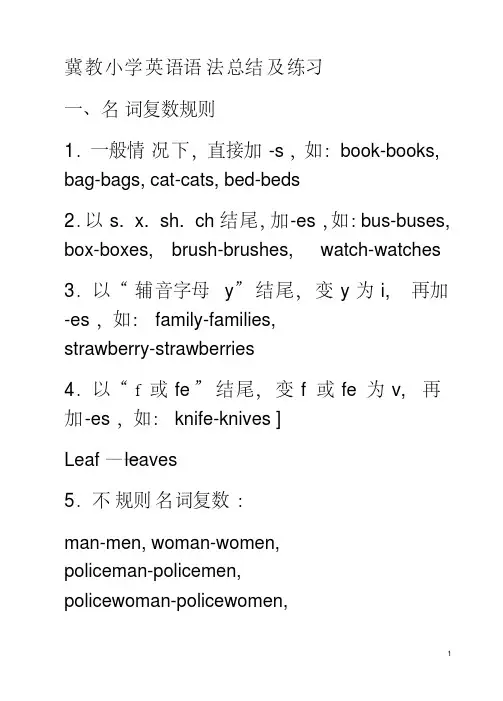
冀教小学英语语法总结及练习一、名词复数规则1.一般情况下,直接加-s,如:book-books, bag-bags, cat-cats, bed-beds2.以s. x. sh. ch结尾,加-es,如:bus-buses, box-boxes, brush-brushes, watch-watches3.以“辅音字母y”结尾,变y为i, 再加-es,如:family-families,strawberry-strawberries4.以“f或fe”结尾,变f或fe为v, 再加-es,如:knife-knives ]Leaf——l eaves5.不规则名词复数:man-men, woman-women,policeman-policemen,policewoman-policewomen,child-childrenfoot-feet,.tooth-teethfish-fish, people-people,Chinese-Chinese, Japanese-Japanese写出下列各词的复数I _________him _________this___________her ______watch _______child _______photo________diary ______day________ foot________ book_______ dress ________tooth_______ sheep ______box_______ strawberry _____peach______ sandwich______dish_______bus_______man______ woman_______二、一般现在时一般现在时基本用法介绍【No. 1】一般现在时的功能1.表示事物或人物的特征、状态。
如:The sky is blue.天空是蓝色的。
2.表示经常性或习惯性的动作。

a, an, the的用法精讲及练习是虚词,本身不能单独使用,也没有词义,它用在名词的前面,帮助指明名冠词the Definite Article),另一种词的含义。
英语中的冠词有三种,一种是定冠词(the Indefinite ArticleZero Article)。
),还有一种是零冠词(是不定冠词(”“an, a但不强调数目观一是不定冠词,仅用在单数可数名词前面,表示的意义,an a用在以元音(指元素音素)念。
用在以辅音(指辅音音素)开头的词前,”“the ,a,/an,。
是定冠词,翻译成如果泛指某物修饰特指名词用这个开头的词前。
the.具体指某物的话,用an1时,条件有三:①这个名词的读音必须是以元音音素)当我们使用注意:(--音标的第一个音素是元音,而不是说它是以元音字母开头。
②它即它的开头必须是个可数名词。
③它还必须是个单数名词。
我们常常见到这类用法:an hour a university 一个小时一所大学an engineer an orange 一位工程师一只桔子an honest person an ordinary man 一位诚实的人一个普通人 a boy, a city, a girl, a useful animal , an old man, an honest boy,a bad apple, a tall elephant,niversity(u ), a 是元音字母,但不读元音u虽然)(h an our 不是元音,但单词读音是元音开头h虽然一个小时用于元音音素开头的用于辅音音素开头的词前,anan不定冠词有a和两种:a 词前。
例如:a boy, a city, a girl, a useful animal , an old man, an honest boy,),niversity(a bad apple, a tall elephant,a an 是元音字母,但不读元音u虽然u ) 不是元音,但单词读音是元音开头一个小时h our (虽然h1.指某类人或事物中的任何一个。

英语语法1.名词1.1名词复数的规则变化1.2其他名词复数的规则变化1.3名词复数的不规则变化1.4不可数名词量的表示1.5定语名词的复数1.6不同国家的人的单复数1.7名词的格2.冠词和数词2.1不定冠词的用法2.2定冠词的用法2.3零冠词的用法2.4冠词与形容词+名词结构2.5冠词位置2.6数词3.代词3.1人称代词的用法3.2人称代词之主、宾格的替换3.3代词的指代问题3.4并列人称代词的排列顺序3.5物主代词3.6双重所有格3.7反身代词3.8相互代词3.9指示代词3.10疑问代词3.11关系代词3.12every , no, all, both, neither, nor3.13none, few, some, any, one, ones3.14代词比较辩异 one,that 和it3.15one/another/the other3.16“the”的妙用3.17anyone/any one;no one/none;every/each3.18both, either, neither, all, any, none3.19many, much3.20few, little, a few, a little4.形容词和副词4.1形容词及其用法4.2以-ly结尾的形容词4.3用形容词表示类别和整体4.4多个形容词修饰名词的顺序4.5副词及其基本用法4.6兼有两种形式的副词4.7形容词与副词的比较级4.8as + 形容词或副词原级 + as4.9比较级形容词或副词 + than4.10可修饰比较级的词4.11many,old 和 far4.12the + 最高级 + 比较范围4.13和more有关的词组5.动词5.1系动词5.2什么是助动词5.3助动词be的用法5.4助动词have的用法5.5助动词do的用法5.6助动词shall和will的用法5.7助动词should和would的用法5.8短语动词5.9非谓语动词6.动名词6.1动名词作主语、宾语和表语6.2Worth的用法7动词不定式7.1不定式作宾语7.2不定式作补语7.3不定式主语7.4It's for sb.和 It's of sb.7.5不定式作表语7.6不定式作定语7.7不定式作状语7.8用作介词的to7.9省to 的动词不定式7.10动词不定式的否定式7.11不定式的特殊句型too…to…7.12不定式的特殊句型so as to 7.13不定式的特殊句型Why not 7.147不定式的时态和语态7.15动名词与不定式8.特殊词精讲8.1stop doing/to do8.2forget doing/to do8.3remember doing/to do8.4regret doing/to do8.5cease doing/to do8.6try doing/to do8.7go on doing/to do8.8be afraid doing/to do8.9be interested doing/to do 8.10mean to doing/to do8.11begin(start) doing/to do8.12感官动词 + doing/to do9.分词9.1分词作定语9.2分词作状语9.3连词+分词(短语)9.4分词作补语9.5分词作表语9.6分词作插入语9.7分词的时态9.8分词的语态10.独立主格10.1独立主格10.2With的复合结构11.动词的时态11.1一般现在时的用法11.2一般过去时的用法11.3used to / be used to 11.4一般将来时11.5be going to / will11.6be to和be going to11.7一般现在时表将来11.8用现在进行时表示将来11.9现在完成时11.10比较过去时与现在完成时11.11用于现在完成时的句型11.12比较since和for11.13since的四种用法11.14延续动词与瞬间动词11.15过去完成时11.16用一般过去时代替完成时11.17将来完成时11.18现在进行时11.19不用进行时的动词11.20过去进行时11.21将来进行时11.22一般现在时代替将来时11.23一般现在时代替过去时11.24一般现在时代替完成时11.25一般现在时代替完成时11.26一般现在时代替进行时11.27现在进行时代替将来时11.28时态一致1.29时态与时间状语12.动词的语态12.1Let的用法12.2短语动词的被动语态12.3表示"据说"或"相信" 的词组12.4不用被动语态的情况12.5主动形式表示被动意义12.6被动语态表示主动意义12.7need/want/require/worth13.句子的种类13.1句子的种类13.2感叹句结构13.3强调句结构13.4用助动词进行强调13.5反意疑问句14.倒装14.1倒装句之全部倒装14.2倒装句之部分倒装14.3以否定词开头作部分倒装14.4so, neither, nor作部分倒装14.5only在句首要倒装的情况14.6as, though 引导的倒装句14.7其他部分倒装15.主谓一致15.1并列结构作主语谓语用复数15.2主谓一致中的靠近原则15.3谓语动词与前面的主语一致15.4谓语需用单数15.5指代意义决定谓语的单复数15.6与后接名词或代词保持一致16.虚拟语气16.1真是条件句16.2非真实条件句16.3混合条件句16.4虚拟条件句的倒装16.5特殊的虚拟语气词:should16.6wish的用法16.7比较if only与only if16.8It is (high) time that16.9need "不必做"和"本不该做"17.名词性从句17.1引导名词性从句的连接词17.2名词性that-从句17.3名词性wh-从句17.4if, whether引导的名词从句17.5否定转移18.定语从句18.1关系代词引导的定语从句18.2关系副词引导的定语从句18.3判断关系代词与关系副词18.4限制性和非限制性定语从句18.5介词+关系词18.6as, which 非限定性定语从句18.7先行词和关系词二合一18.8what/whatever;that/what; who/whoever18.9关系代词that 的用法19.状语从句19.1地点状语从句19.2方式状语从句19.3原因状语从句19.4目的状语从句19.5结果状语从句19.6条件状语从句19.7让步状语从句19.8比较while, when, as19.9比较until和till19.10表示"一…就…"的结构20.连词20.1并列连词与并列结构20.2比较and和or20.3表示选择的并列结构20.4表示转折或对比20.5表原因关系20.6比较so和 such21.情态动词21.1情态动词的语法特征21.2比较can 和be able to21.3比较may和might21.4比较have to和must21.5比较have to和must21.6must表示推测21.7表示推测的用法21.8情态动词+ have +过去分词21.9should 和ought to21.10had better表示"最好"21.11would rather表示"宁愿"21.12will和would21.13情态动词的回答方式21.14带to 的情态动词21.15比较need和dare1.名词名词可以分为专有名词(Proper Nouns)和普通名词(Common Nouns),专有名词是某个(些)人,地方,机构等专有的名称,如Beijing,China等。
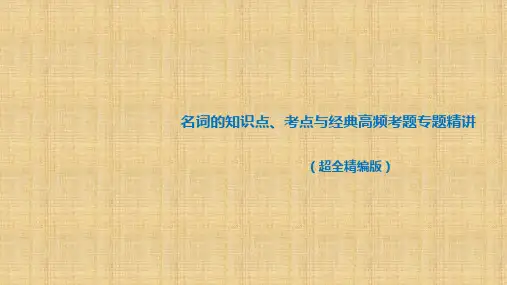
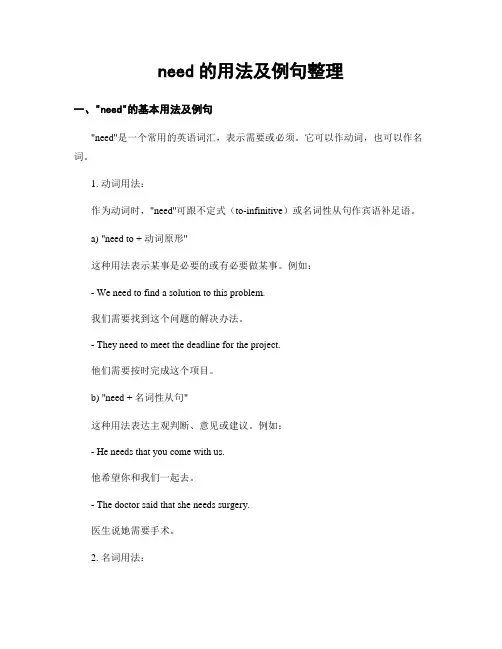
need的用法及例句整理一、"need"的基本用法及例句"need"是一个常用的英语词汇,表示需要或必须。
它可以作动词,也可以作名词。
1. 动词用法:作为动词时,"need"可跟不定式(to-infinitive)或名词性从句作宾语补足语。
a) "need to + 动词原形"这种用法表示某事是必要的或有必要做某事。
例如:- We need to find a solution to this problem.我们需要找到这个问题的解决办法。
- They need to meet the deadline for the project.他们需要按时完成这个项目。
b) "need + 名词性从句"这种用法表达主观判断、意见或建议。
例如:- He needs that you come with us.他希望你和我们一起去。
- The doctor said that she needs surgery.医生说她需要手术。
2. 名词用法:作为名词时,"need"表示需求或必要之物。
它可以单独使用,在句子中充当主语、宾语或补足语,并可搭配不同的介词使用。
例如:a) "The need for + 名词"该结构指某物被认为是所需之物。
例如:- The need for clean water is crucial in developing countries.在发展中国家,干净水源的需求至关重要。
- There is a growing need for renewable energy sources.对可再生能源的需求越来越大。
b) "In need of + 名词/动名词"这种表达方式指某人或某物需要某事物。
例如:- She is in need of assistance with her homework.她需要在家庭作业方面得到帮助。
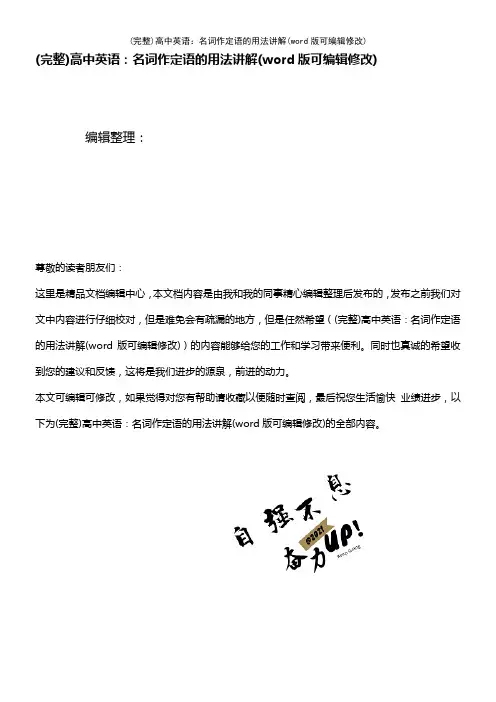
(完整)高中英语:名词作定语的用法讲解(word版可编辑修改)编辑整理:尊敬的读者朋友们:这里是精品文档编辑中心,本文档内容是由我和我的同事精心编辑整理后发布的,发布之前我们对文中内容进行仔细校对,但是难免会有疏漏的地方,但是任然希望((完整)高中英语:名词作定语的用法讲解(word版可编辑修改))的内容能够给您的工作和学习带来便利。
同时也真诚的希望收到您的建议和反馈,这将是我们进步的源泉,前进的动力。
本文可编辑可修改,如果觉得对您有帮助请收藏以便随时查阅,最后祝您生活愉快业绩进步,以下为(完整)高中英语:名词作定语的用法讲解(word版可编辑修改)的全部内容。
高中英语:名词作定语的用法讲解作定语的名词往往是说明其中名词的材料、用途、时间、地点、内容、类别等。
下面是是名词作定语的用法讲解,大家可以参考学习。
一、名词作定语的基本原则名词作定语原则上用单数,不用复数.如:a stone bridge 石桥 (不能说 a stones bridge)a meeting room 会议室 (不能说 a meetings room)morning exercise 早操 (不能说 a mornings exercise)a story book 故事书 (不能说 a stories book)a coffee cup 咖啡杯(不能说 a coffees cup)a baby girl 女婴(不能说 a babies girl)a school gate 校门(不能说a schools gate)eye drops眼药水(不能说eyes drops)test paper考卷(不能说tests paper)book report读书报告(不能说books report)train station火车站(不能说trains station)plane ticket机票(不能说plane tickets)pocket money零花钱(不能说pockets money)generation gap代沟(不能说generations gap)二、用复数名词作定语的四种情形:1. 有些只有复数形式的名词,则用复数作定语:goods train 货车clothes shop 服装店an arts degree文科学位customs officer海关人员2。

英语语法习题目录第一讲主谓一致第二讲名词第三讲代词第四讲动词分类第五讲动词时态第六讲被动语态第七讲虚拟语气第八讲助动词第九讲不定式第十讲 V-ing形式第十一讲 V-ed 形式第十二讲形容词/副词第十三讲介词第十四讲连词第十五讲 It的用法第十六讲定语从句第十七讲名词性从句第十八讲状语从句第十九讲倒装句第一讲主谓一致I.学习重点从句或非谓语动词作主语时的主谓一致表示数量的名词词组作主语时的主谓一致由连接词连接的主语与谓语的一致集体名词作主语时的主谓一致“主语 +with/as well as等短语”的主谓一致Ⅱ.重点讲解主语和谓语的一致主要指谓语动词必须和作主语的名词或人称代词在人称和数上保持一致。
处理主谓一致关系主要遵循以下3 条原则。
①语法一致原则,即谓语的单、复数形式依主语的单、复数形式而定:主语为复数,谓语动词用复数;主语为单数或是不可数名词,谓语动词用单数。
②就近一致原则,即谓语动词的人称和数要与它最邻近的名词或代词保持一致。
③意义一致原则,即不以语法形式而从意义着眼处理一致关系,若主语形式上为复数,但意义上是单数,谓语动词需用单数;若主语形式上为单数,而意义上是复数,则谓语动词用复数。
Ⅲ、自测题1. The committee ______(be) unable to agree on the policies.2. The committee______ (have)decided to give the workers more financial help .3. Why he entered the house and how he managed to get out of it without being seenby people ______ (remain) a mystery to us all.4. Three years in a strange land ______(seem) like a long time.5. He is one of those men who never ______(care) how they look.6. Law and order ______(mean) different things to people with different politicalopinions.7. She’ s the only one of these women who ______ (play) bridge well.8. After the exams ______(be) the time to relax.9. War and peace ______(be) a constant theme in history.10. How is it that your answer and your neighbour’ s ______(be) identical?11. If either of you ______(take) a vacation now,we will not be able to finish the work.12. One third of the population ______(be) working in factories.13. There ______(be) a bed and two sofas in the room.14. What he left me ______(be) three small rooms.15. The crowd at the basketball game ______(be) wild with excitement.16. None of the students ______(have)finished the exam yet.17. A large crowd of people ______(have) gathered under the Town Hall clock.18. All but he and I ______(be) going to the Exhibition.19. Each soldier and sailor ______(be) given a gun.20. Attending on campus concerts______ (be)part of the pleasure of college life.21. There ______(be) more than one answer to your question.22. A number of pages ______(be) found missing.23. This is one of the books that______(tell)an authentic story of World War Two.24. The cat with her kittens ______(be) sitting in the sun.25. What ______(be) your weekly wages?26. Bacon and eggs ______(make) a hearty breakfast for a growing boy.27. Dancing and skating ______(be) my chief delights.28. Only one of the students who______(have) read the article can answerthe question.29. John is the only student who ______(have) read the book.30. The number of secretaries in this company ______(be)never under 100.31. Five hundred dollars ______(be) spent yesterday.32. It is I who ______(be) responsible for this.33. To visit the parks and museums ______(be) really enjoyable.34. Every word and phrase in this dictionary ______(be) important.35. What he wants ______(be) a recorder and a radio.36. There ______(be) many a reason why this book sells well.37. What caused the damage of these cars ______(remain) unknown.38. Two thirds of my friends ______(have) been abroad.39. Two thirds of the crop ______(have) been damaged by the storm.40 . The Adventures of Sherlock Holmes ______(have)been translated into many languages .41. A thousand miles no longer ______ much to us today,for modern jets can easilyget us over this distance within a few hours.A)meant B)meanC)means D)will mean42. It is reported that about two-thirds of the factory’ s property_______ in the fire.A)are lost B)have been lostC)were lost D)has been lost43.Statistics ______ a rather modern branch of mathematics.A)are B)wereC)is D)are to be44.Every means ______ tried out but never with success,as far as myknowledge goes .A)is B)has beenC)are D)have been45 . The woman writer and Oscar Award candidate _______ a collection of shortstories.A)have just turned out B)has just turned outC)have just been turned out D)has just been turned out46. The athlete,together with his coach and several relatives,_____to the Olympic Games.A)are traveling B)is travelingC)were traveling D)have been traveling47. Not only I but also Tom and Mary ______ fond of watching television.A)am B)isC)are D)have48. The audience _______ requested to be in their seats by 7:00.A)have B)hasC)are D)is49. Your trousers ______ too long.______ to be shortened a little.A)are;They need B)is;It needsC)are;It needs D)is;They need50. Different forms of government agency ______ different functions.A)is B)areC)has D)have第二讲名词I.学习重点可数名词与不可数名词名词的复数词尾变化形式名词所有格名词作定语复合名词作定语时的数单位词Ⅱ.重点讲解名词是表示人、事物和抽象概念的词,它在句中可以作主语、宾语、表语、同位语以及后置定语。
名词: 1、英语名词可分专有名词和普通名词两类: a、专有名词是个别的人、地、物、团体、机构等的专用名称。专有名词中实词的第一个字母要大写。如:Beijing, Tom, the People’s Republic of China(中华人民共和国) 专有名词如果是含有普通名词的短语,则必须使用定冠词the。如:the Great Wall(长城) 姓氏名如果采用复数形式,则表示该姓氏一家人(复数含义),如:the Greens( 格林一家人)。 b、普通名词是许多人或事物的共有名称。如:pupil, family, man, foot. 普通名词又分为可数名词和不可数名词。 ▲可数名词是可以用简单的数词进行计数的名词,如: box, child, orange; ▲不可数名词是不可以用简单的数词进行计数的名词。如:water, news, oil, population, information . 2、英语可数名词的单复数:英语可数名词有单数和复数两种形式。 复数形式通常是在单数形式后加词尾“-s”构成,其主要变法如下: (1)一般情况在词尾加-s,例如:book→books,girl→girls,boy→boys,pen→pens,doctor→doctors, boy→boys。 (2) 以s,x,ch,sh,结尾的词加-es,例如:bus→buses,class→classes,box→boxes,watch→watches,brush→brushes。 (3)以ce, se, ze,(d)ge结尾的名词加s,例如:orange—oranges。 (4)以辅音母加y结尾的词变“y”为“i”再加-es,例如:city→cities, factory→factories, country→countries, family→families。但要注意的是以元音字母加y结尾的名词的复数形式只加s,如:boy→boys, day→days。 (5)以o结尾的词多数都加-es。例如:hero→heroes,potato→potatoes,tomato→tomatoes,但词末为两个元音字母的词只加-s。例如:zoo→zoos,radio→radios,还有某些外来词也只加-s,例如:photo→photos,piano→pianos。 (6) 以f或fe结尾的词,多数变f为v再加-es,例如:knife→knives,leaf→leaves, half→halves。 复数词尾s(或es)的读音方法如下表所示。 复数词尾s(或es)的读音方法 情 况 读法 例 词
在[p][t][k][f]等清辅音后 [s]
cups, hats, cakes 在[s][z][t]等音后 [iz] glasses, pages, oranges, buses,
watches,faces
在[b][d][][v]等浊辅音后 [z] beds, dogs, cities, knives
(7)少数名词有不规则的复数形式,例如:man→men,woman→women,tooth→teeth,foot→feet,child→children,mouse→mice。 【注意】与man和woman构成的合成词,其复数形式也是-men和-women。例如:an Englishman,two Englishmen。但German不是合成词,故复数形式为 Germans;man, woman等作定语时,它的单复数以其所修饰的名词的单复数而定,如:men workers, women teachers。 有个别名词单复数一样,例如:Chinese,Japanese,sheep,deer,fish等。但当fish表示不同种类的鱼时,可以加复数词尾。 (8)单数形式但其意为复数的名词有:people, police等。 (9)数词+名词作定语时,这个名词一般保留单数形式,中间加连字符。例如:ten-minutes’ walk, an 8-year-old girl, a ten-mile walk。 (10)还有些名词仅有复数形式,如:trousers,clothes,chopsticks,glasses,goods,ashes,scissors,compasses。 (11)只用作单数的复数形式的名词有: 科学名词:physics, mathematics/maths 专有名词:the United States, Niagara Falls 其他名词:news, falls 另有不规则变化: man→men,woman→women, sheep→sheep,tooth→teeth, fish→fish,child→children, ox→oxen, goose→geese
3 不可数名词“量”的表示方法
在英语中,不可数名词如果要表示“量”的概念,可以用以下两种方法: (1)用much, a little, a lot of/lots of, some, any等表示多少,例如: The rich man has a lot of money. There is some milk in the bottle. Is there any water in the glass? I don't like winter because there's too much snow and ice. (2)用a piece of 这类定语,例如: a piece of paper, a piece of wood, a piece of bread a bottle of orange, a glass of water(milk) a cup of tea a bag of rice ,three bags of rice 如果要表示“两杯茶”、“四张纸”这类概念时,在容器后加复数,例如: two cups of tea four pieces of paper three glasses of water
不可数名词也可用a lot of, lots of, some, any, much等来修饰。不可数名词一般没有复数形式,说明其数量时,要用有关计量名词。如:a bag of rice→two bags of rice, a piece of paper→three pieces of paper, a bottle of milk→five bottles of milk. ◆ 不可数名词用法举要 ◆
不可以用数目来计算的名词称为不可数名词。学习不可数名词时,应注意以下几点:
▲不可数名词没有复数形式。如:some meat , some bread , 不可说 some meats , some breads 。
▲不可数名词不能用不定冠词 a , an 及数词修饰,但可用 some , any , much (许多),a lot of (许多),a little(一点)等直接修饰。如:我们不可以说a tea , two milk , 但可以说 some tea , much meat 。 ▲不可数名词前通常用量词来表示具体的数。如:a glass of water , two cups of tea , five pieces of bread 。需要注意的是:类似短语中的介词 of 不能省去,当数词大于“一”时,量词需要用复数形式。
▲不可数名词作主语时,谓语动词用单数形式。例如:
There is some water in the bottle . 瓶里有些水。
Is there any rice in the bag ? 袋子里有米吗? ▲若不可数名词前有复数数量词修饰时,谓语动词用复数形式。例如: There are three bottles of orange on the table . 桌上有三瓶桔汁。
试比较:There is some orange on the table . ▲对不可数名词前的修饰语提问,疑问词用 how much 。例如:
They want two cups of tea . →How much tea do they want ? There is some milk in the glass . →How much milk is there in the glass ? ▲对不可数名词前量词部分的修饰语提问题,疑问词用 how many 。例如: They want two cups of tea . →How many cups of tea do they want ?
▲不可数名词表示特指时可用定冠词 the 修饰。例如:
The bread on the table is Li Lei’s . 桌上的面包是李磊的。
▲有些名词即可作可数名词,也可作不可数名词,但意思却大不相同。如:glass 作可数名词,意思是“玻璃杯”,作为不可数名词,意思是“玻璃”;room 作可数名词,意思是“房间”,作不可数名词,意思是“空间”。